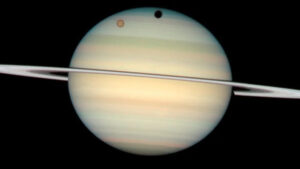When you buy through links on our articles, Future and its syndication partners may earn a commission.

Every 15 years, people on Earth can see the shadow (red box) of Saturn’s largest moon Titan (green box) move across the ringed planet. This photo was taken by the Hubble Space Telescope in 2009. | Credit: NASA, ESA, and the Hubble Heritage Team (STScI/AURA); Acknowledgment: M.H. Wong (STScI/UC Berkeley) and C. Go (Philippines)
Over the next few months, there will be several chances to see a giant “hole” shoot across the surface of Saturnas the shadow of its largest moon passes across the ringed planet’s Earth-facing surface. The rare spectacle will not be visible again until 2040 — and we’ll tell you how to see it from your backyard.
Every 15 years, Saturn and Earth become perfectly aligned so that the gas giant’s rings face our planet head-on. In March, this alignment was so perfect that the planet’s super-thin rings completely disappeared from view, Live Science’s sister site Space.com previously reported. In 2032, the opposite will occur, and we will be able to see the entirety of the dusty disks in a perfect circle around the fifth planet from the sun.
Saturn’s current orientation also means that the planet’s largest moon, Titan, circles it in a way that causes its large shadow to repeatedly transit the planet’s surface, similar to how the moon’s shadow races across Earth during a lunar eclipse. The same phenomenon also happens to some of Saturn’s other major moons, including Mimas and Rhea. However, their respective shadows are smaller and lighter than Titan’s, making it harder to see them.
Titan orbits Saturn roughly every 16 days, meaning that there will be a total of 10 transits visible while Earth is still aligned with the ringed gas giant. Three of these transits have already happened, most recently on June 16. But there are still seven more occasions when the spectacle could be visible between now and mid-autumn, depending on your location and weather conditions at the time.
The remaining transits will occur on July 2, July 18, Aug. 3, Aug. 19, Sept. 4, Sept. 20 and Oct. 6, according to Sky & Telescope. For exact times, check the table below.
Related: Saturn gains 128 new moons, giving it more than the rest of the solar system combined

Credit: Illustration: NASA, ESA, and Z. Levay (STScI); Image: NASA, ESA, and the Hubble Heritage Team (STScI/AURA); Acknowledgment: M.H. Wong (STScI/UC Berkeley) and C. Go (Philippines)
Titan will also be visible during these transits, although its position relative to the shadow changes with each viewing, as Saturn continues to circle the sun. But it will be slightly smaller than the shadow it casts.
To see the spectacular transits for yourself, you will need a good telescope with at least 200x magnification. From North America, most of the transits will start and end before sunrise. To find where Saturn will be in the night sky, you can use websites such as TheSkyLive.com.
However, we recommend that you don’t leave it to the last minute, because adverse weather conditions could completely obscure your view. As you can see from the table below, the length of transits will also decrease each time, which means you will have to be more precise with your timings later in the year; On Oct. 6, the shadow will only be momentarily visible when Titan is exactly at mid-transit.
|
Date |
Transit Start (East) |
Mid-Transit (East) |
Transit End (East) |
Transit duration (minutes) |
|
July 2 |
03:40 |
06:35 |
09:03 |
323 |
|
July 18 |
03:00 |
05:44 |
08:05 |
305 |
|
Aug. 3 |
02:25 |
04:52 |
07:04 |
279 |
|
Aug. 19 |
01:52 |
04:01 |
06:00 |
248 |
|
Sept. 4 |
01:25 |
03:09 |
04:50 |
205 |
|
Sept. 20 |
01:09 |
02:20 |
03:34 |
145 |
|
Oct. 6 |
N/A |
01:32* |
N/A |
1 |
But even if you miss the impressive shadow over the next few months, you will still be able to see Titan pass in front of Saturn every 16 days, up until January 2026, when it will stop transiting the planet until 2040.
RELATED STORIES
—There’s liquid on Titan, Saturn’s largest moon. But something’s missing and scientists are confused.
—Saturn’s ‘Death Star’ moon Mimas may have an underground ocean scientists never believed could exist
—There’s a weird, disappearing dark spot on Saturn’s moon Enceladus
If you are lucky enough to see the stunning celestial spectacle, be sure to keep in mind that Titan is the second-largest moon in the solar system, behind Jupiter’s behemoth satellite Ganymede. At more than 3,200 miles (5,150 kilometers) across, it is also slightly bigger than the planet Mercury and 50% wider than Earth’s moon.
It is also the only one of the solar system’s moonsother than Earth’s, that has been visited by a human-made spacecraft. The European Space Agency’s Huygens probe landed on the Saturnian satellite in 2005 — and it is still there today.











